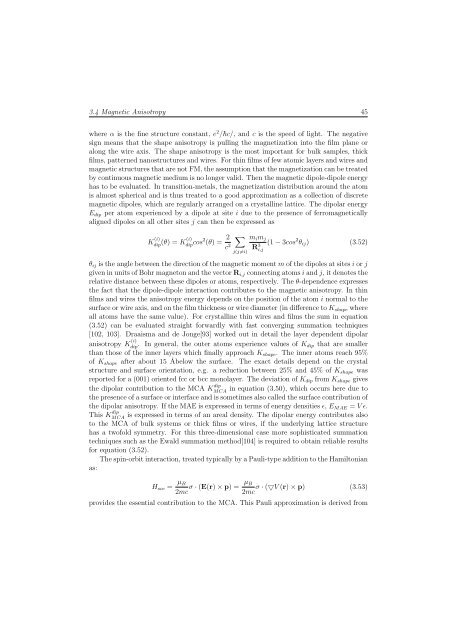Ab initio investigations of magnetic properties of ultrathin transition ...
Ab initio investigations of magnetic properties of ultrathin transition ...
Ab initio investigations of magnetic properties of ultrathin transition ...
You also want an ePaper? Increase the reach of your titles
YUMPU automatically turns print PDFs into web optimized ePapers that Google loves.
3.4 Magnetic Anisotropy 45<br />
where α is the fine structure constant, e 2 /�c/, and c is the speed <strong>of</strong> light. The negative<br />
sign means that the shape anisotropy is pulling the magnetization into the film plane or<br />
along the wire axis. The shape anisotropy is the most important for bulk samples, thick<br />
films, patterned nanostructures and wires. For thin films <strong>of</strong> few atomic layers and wires and<br />
<strong>magnetic</strong> structures that are not FM, the assumption that the magnetization can be treated<br />
by continuous <strong>magnetic</strong> medium is no longer valid. Then the <strong>magnetic</strong> dipole-dipole energy<br />
has to be evaluated. In <strong>transition</strong>-metals, the magnetization distribution around the atom<br />
is almost spherical and is thus treated to a good approximation as a collection <strong>of</strong> discrete<br />
<strong>magnetic</strong> dipoles, which are regularly arranged on a crystalline lattice. The dipolar energy<br />
Edip per atom experienced by a dipole at site i due to the presence <strong>of</strong> ferro<strong>magnetic</strong>ally<br />
aligned dipoles on all other sites j can then be expressed as<br />
K (i)<br />
dip (θ) =K(i)<br />
dipcos2 (θ) = 2<br />
c2 �<br />
j(j�=i)<br />
mimj<br />
R3 (1 − 3cos<br />
i,j<br />
2 θij) (3.52)<br />
θij is the angle between the direction <strong>of</strong> the <strong>magnetic</strong> moment m <strong>of</strong> the dipoles at sites i or j<br />
given in units <strong>of</strong> Bohr magneton and the vector Ri,j connecting atoms i and j, it denotes the<br />
relative distance between these dipoles or atoms, respectively. The θ-dependence expresses<br />
the fact that the dipole-dipole interaction contributes to the <strong>magnetic</strong> anisotropy. In thin<br />
films and wires the anisotropy energy depends on the position <strong>of</strong> the atom i normal to the<br />
surface or wire axis, and on the film thickness or wire diameter (in difference to Kshape where<br />
all atoms have the same value). For crystalline thin wires and films the sum in equation<br />
(3.52) can be evaluated straight forwardly with fast converging summation techniques<br />
[102, 103]. Draaisma and de Jonge[93] worked out in detail the layer dependent dipolar<br />
anisotropy K (i)<br />
dip . In general, the outer atoms experience values <strong>of</strong> Kdip that are smaller<br />
than those <strong>of</strong> the inner layers which finally approach Kshape. The inner atoms reach 95%<br />
<strong>of</strong> Kshape after about 15 ˚<strong>Ab</strong>elow the surface. The exact details depend on the crystal<br />
structure and surface orientation, e.g. a reduction between 25% and 45% <strong>of</strong> Kshape was<br />
reported for a (001) oriented fcc or bcc monolayer. The deviation <strong>of</strong> Kdip from Kshape gives<br />
the dipolar contribution to the MCA K dip<br />
MCA<br />
in equation (3.50), which occurs here due to<br />
the presence <strong>of</strong> a surface or interface and is sometimes also called the surface contribution <strong>of</strong><br />
the dipolar anisotropy. If the MAE is expressed in terms <strong>of</strong> energy densities ɛ, EMAE = Vɛ.<br />
This K dip<br />
MCA is expressed in terms <strong>of</strong> an areal density. The dipolar energy contributes also<br />
to the MCA <strong>of</strong> bulk systems or thick films or wires, if the underlying lattice structure<br />
has a tw<strong>of</strong>old symmetry. For this three-dimensional case more sophisticated summation<br />
techniques such as the Ewald summation method[104] is required to obtain reliable results<br />
for equation (3.52).<br />
The spin-orbit interaction, treated typically by a Pauli-type addition to the Hamiltonian<br />
as:<br />
Hsoc = μB<br />
μB<br />
σ · (E(r) × p) = σ · (▽V (r) × p) (3.53)<br />
2mc 2mc<br />
provides the essential contribution to the MCA. This Pauli approximation is derived from

















